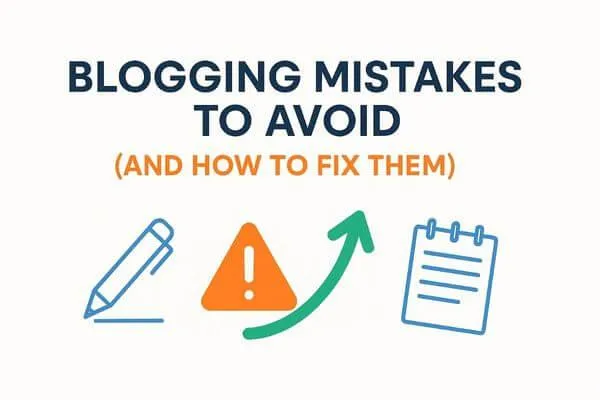
Blogging Mistakes to Avoid: How to Fix Them and Grow Faster
Introduction
I’ve seen so many business owners get excited, launch a blog, and then six months later…it’s a ghost town. Not because they weren’t smart or hard-working — but because they started without a plan.
Here’s the good news: mistakes aren’t failures. They’re neon signs pointing to what you need to fix. Once you spot them, you can turn things around and grow faster than you thought possible.
The Quick Answer
The biggest blogging mistakes to avoid are:
Starting without a clear strategy
Writing for yourself instead of clients
Waiting for “perfect” before publishing
Ignoring SEO basics
Publishing inconsistently and skipping promotion
Not tracking results or improving
The fixes are simple: set goals, answer client questions, publish consistently, apply SEO basics, and let analytics guide your next steps. Do that, and your blog will stop spinning its wheels and start gaining traction.

Key Takeaways
Mistakes aren’t the end — they’re opportunities to grow.
Strategy beats guesswork: start with clear goals.
80% done and published beats 100% perfect and stuck in drafts.
Answer client questions (TAYA style) — not what you want to push.
Tracking what works and what doesn’t is a win/win.
Mistake #1 — Blogging Without a Clear Goal or Strategy
Problem: Without a plan, your blog becomes a random collection of posts that don’t connect or drive results.
Fix: Define your goals before you ever hit publish. Are you trying to generate leads? Build authority? Educate customers? Your goals shape your topics, your tone, and even your keywords.
👉 In my SEO teaching, I always remind people: strategy comes first, keywords second. Otherwise, you’re building on sand.
Stat: According to CoSchedule, marketers who set clear goals are 376% more likely to report success than those who don’t.
Mistake #2 — Writing for Yourself Instead of Your Clients
Problem: Too many blogs sound like company press releases. They push your agenda instead of answering your client’s real questions.
Fix: Follow the They Ask, You Answer (TAYA) framework. If clients ask it in meetings, emails, or sales calls, it belongs on your blog. Simple as that.
Example: Instead of “Our New Service Update,” write “How Much Does [Service] Cost?” That’s the question your audience is Googling.
Stat: 47% of buyers view 3–5 pieces of content before contacting a sales rep (Demand Gen Report). Make sure your posts answer the exact questions they’re already searching.
Mistake #3 — Perfection Paralysis (Waiting for 100%)
Problem: Drafts sit unpublished because you’re tweaking endlessly.
Fix: Adopt the 80% and done mindset. Progress beats perfection every time. A good post that’s live will always outperform a perfect post that never leaves your drafts folder.
I’m not saying publish sloppy work. I’m saying get it to 80%, ship it, and improve as you go. Trust me, I’ve had posts go live that weren’t perfect — but they still got traction, and I learned faster because they were out in the world.
Mini How-To: To beat perfectionism:
Set a timer for final edits (e.g., 30 minutes max).
Hit publish when the timer ends.
Schedule a reminder to revisit in 60 days and update.
Mistake #4 — Ignoring SEO Basics
Problem: Great content gets buried because search engines can’t find it.
Fix: Learn and apply the basics:
Clear title tag
Compelling meta description
Use of secondary keywords
Adding schema markup when possible

I just covered these fundamentals inside my Skool classroom — and the lightbulb moments were huge. Even small tweaks can mean the difference between showing up on page 1 or being invisible on page 10.
FAQ tie-in: Do I really need SEO for every blog post? Yes — even the basics improve discoverability. Think of SEO as a megaphone: it makes sure your answers get heard.
Mistake #5 — Inconsistent Publishing & No Promotion
Problem: Blogs that post sporadically struggle to build momentum.
Fix: Consistency builds trust — with both your readers and search engines. My recommendation:
Aim for 1 post per week, same day, same time.
If that feels too heavy, commit to every two weeks — just keep it steady.
Personally, I’m publishing 2 posts per week right now to jumpstart growth.
That’s not me barking commands — that’s me walking the same path you are. I’m testing, adjusting, and learning alongside you. We’re in this together.
And remember: publishing is only half the battle. Promote your content through email, social, and even repurposing into other formats.
FAQ tie-in: How often should I blog to see results? Once per week is ideal for most businesses. What matters most is consistency — train your audience to expect fresh content from you.
Mistake #6 — Not Tracking, Measuring, or Improving
Problem: Without data, you’re flying blind. You don’t know what’s resonating or where you’re wasting time.
Fix: Analytics aren’t scary — they’re neon signs:
If a post is working → double down and create more like it.
If a post isn’t working → you know exactly what to fix.
It’s a win/win. Data doesn’t judge you; it guides you.
Even basic tools like Google Analytics or Search Console can show you which posts drive traffic, leads, and engagement. Every data point is a shortcut to doing more of what works.
Mini How-To: Start simple — log into Search Console, find your top 5 performing posts, and update them with fresh examples or stats. That one action alone can boost traffic.
Common Bonus Mistakes (Why Blogs Fail)
Chasing trends instead of answering client questions.
Writing for everyone instead of narrowing your niche.
Comparing your blog to giants like HubSpot (they’ve got 50 writers — don’t compare your chapter 1 to their chapter 20).
The truth? Every blogger falls into some of these traps. The winners are the ones who notice, adjust, and keep moving forward.
FAQs
Q: What if my blog has no traffic yet?
A: Every blog starts at zero. Stick with consistency, answer client questions, and optimize for search — momentum will build.
Q: Do I need images and visuals in every blog post?
A: Yes — visuals improve engagement and help readers skim. At minimum, include one graphic or diagram per post. And don’t forget alt text — short, descriptive text that tells search engines what the image is about.
Q: Should I update old blog posts?
A: Absolutely. Updating content with new data, better headlines, or fresh examples is one of the fastest ways to boost rankings.
Q: What are some common blog strategy mistakes?
A: Publishing without clear goals, ignoring SEO, skipping promotion, and not tracking results are the big ones. The good news? Each one is fixable.
Conclusion: Mistakes = Signs to Victory

Mistakes don’t mean you’ve failed. They mean you’re learning. Every mistake you spot is a signpost pointing to your next step.
So here’s your challenge: Pick one mistake from this list and fix it this week. You’ll be surprised how quickly things start moving once you do.
By the way, if you’d like to see more of what I’m teaching inside my Skool group — from SEO basics to building a blog strategy that actually works — [click here to check it out].


